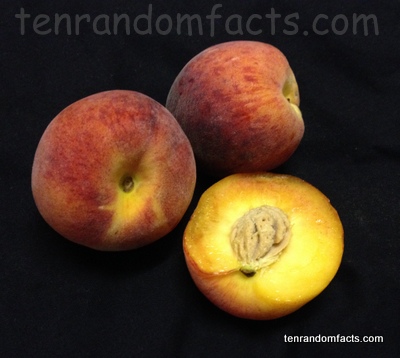Everything’s peaches!
- Peaches are from the genus of cherries and plums, Prunus, and the family of roses, Rosaceae, and they typically have white, yellow or orange coloured flesh, with skin that is generally red or yellow.
- Peaches are furry and feel like velvet, unlike nectarines that are the same species and are technically fuzz-less peaches, even though they are sold as two different fruits.
- Peaches grow on deciduous trees with the scientific name Prunis persica, that grow to be 4 to 10 metres (13 to 33 feet) in height.
- Peaches are stone fruits that have one seed that is 1.3 to 2 centimetres (0.5 to 0.8 inches) long, that is encased in a larger, hard, grooved shell.
- The word ‘peach’ comes from the French word ‘pêche’, and the scientific name of peaches suggests the fruit comes from Persia, however, it is believed that the fruit is native to China.
- Peaches often need to be eaten within two weeks after picking, as they continue to ripen after picking and they can spoil easily.
- China was the biggest producer of peaches in 2011, producing just over half of the total world’s production of 21.5 million tonnes (24 million tons).
- Peaches contain significant amounts of fibre, potassium, vitamin A and vitamin C, with many smaller quantities of many other minerals and vitamins.
- A peach can be either a ‘clingstone’ or a ‘freestone’, meaning that the flesh either ‘clings’ to the stone (seed case), or easily comes free from the stone, respectively.
- Peaches can be eaten raw, canned, dried, cooked, used in baked goods, and made into sauces, and the juices and oil of a peach can be used as a moisturiser.
Bibliography:
Peach, 2013, Wikipedia, http://en.wikipedia.org/wiki/Peach
Peaches, 2011, Fresh for Kids, http://www.freshforkids.com.au/fruit_pages/peach/peach.html







